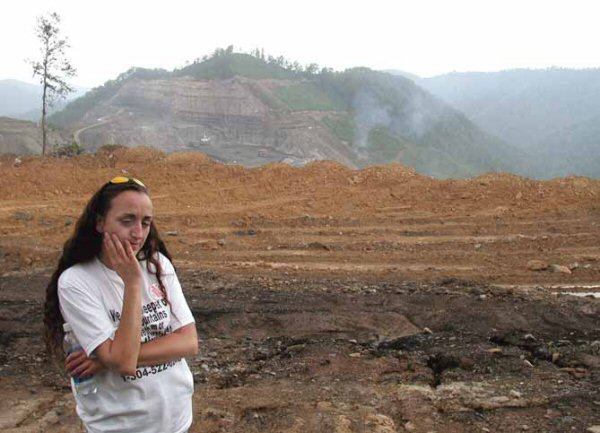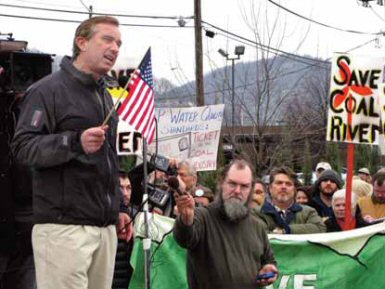SEJournal Online is the digital news magazine of the Society of Environmental Journalists. Learn more about SEJournal Online, including submission, subscription and advertising information.
Feature
By JoANN M. VALENTI
 |
|
Maria Gunnoe, featured in “The Last Mountain,” at a mountaintop removal coal mine site in West Virginia. Photo © Vivian Stockman.
|
The submissions pile to Robert Redford’s Sundance Film Festival, now in its third decade, gets deeper every year. The snowdrifts blanketing Park City, UT remain about the same and half of Hollywood continues to crowd onto Main Street to see films from around the world.
Close to 10,000 wannabe screenings of features, shorts and documentaries poured in for SFF 2011 consideration. Nearly 4,000 fit the feature-length category from which only 118 representing 29 countries and 40 first-time filmmakers were selected. Of those, 95 were world premieres.
Given that Sundance films now regularly make their way to Academy Award nominations — “The Kids Are All Right,” “Winter’s Bone” and “Gasland,” a documentary that pushed fracking onto the nation’s agenda, from SFF 2010 showed up this year as Oscar nominees — industry reps also swarm the mountains looking for deals. Pre-fest buys included a few on my to-see list: HBO grabbed “Project Nim,” adapted from the book reporting the fate of the chimp raised as a human baby then abandoned when the research funds and interest ran dry; Sony Pictures pre-bought “Take Shelter,” more a mental-health story than an omen of climate change-caused natural disasters, but you never know; and a deal seemed imminent for “Perfect Sense,” a thriller/love story set against a global pandemic featuring an epidemiologist who couldn’t keep her clothes on.
Trying to search out environment or science content based on a one- or two-line synopsis made available prior to opening day can get a tad overwhelming. I set my sights on 15 possibilities along with a couple of filmmaker panels that looked promising. The ten-day festival also presents short films, documentaries, and art installations. One artist featured in the New Frontier section of the fest offered an interactive multimedia experiment creating and tracking the spread of a virtual epidemic. Another called “Glowing Pathfinder Bugs” looked intriguing but struggled with malfunctions (insecticide?) and “The Wilderness Downtown” also contributed to the intersection of art, science and filmmaking.
Redford is determined to find audiences for his message.
“Thirty years ago, in 1980, I wanted to create a space where independent artists with new ideas and new voices could have a place to develop,” Redford, the actor/director/producer, NRDC Trustee, said at the opening press conference. Describing how his idea was cobbled together on a shoestring, Redford said, “[a sense of community is] something I always missed in my life.”
Stories presented at Sundance cross borders and cross ways of thinking, he said, and he’s taking advantage of new opportunities to find audiences. Sundance Channel and the Sundance Cinemas have been a start. New launches also include Sundance Select and Sundance shorts on YouTube along with live streams throughout the fest.
The Sundance Institute recently joined with President Obama’s Committee of Arts and Humanities on a global project called Film Forward, and announced new theatre labs in East Africa and India. Also new this year, SFF sent nine films from the festival for simultaneous screening in nine U.S. cities: Seattle; Nashville; San Francisco; Madison; Ann Arbor; Brookline, MA; Chicago; Los Angeles; and Brooklyn. Five films were also made available on Video On Demand on several television outlets for a month following the festival. Redford is committed to spreading the word from his community of indies.
 |
|
Robert F. Kennedy, Jr. addressing a West Virginia gathering opposed to mountaintop removal coal mining. Photo © Eric Grunebaum.
|
Attending celebs this year included Robert F. Kennedy, Jr. appearing in Bill Haney’s doc “The Last Mountain.” In an interview I berated Haney with my pessimism over last mountains, last lions, ongoing devastation, the results of enviro issues tackled for the duration of Redford’s festival, seemingly, with not much effect. Haney’s film documents mountain top removal for mining and burning of coal with some seriously dramatic dynamiting in Appalachia that spreads pollution to other states and particularly endangers people living in nearby West Virginia valleys. In the film Kennedy says, “If people could see this there would be a revolution.” Really?
The film offers the usual awe-inspiring scenes and a slew of superimposed facts: 30 percent of coal comes from Appalachia, burning is the number one source of greenhouse gases worldwide, in a six-year period one coal company (Massey Energy) committed over 60,000 environmental violations, etc. etc. The film stays away from total doom and gloom by offering more data to argue for a wind industry solution. The wind industry in the U.S. already employs as many people as currently work in the coal industry and operates some 35,000 turbines according to the film’s narration. Canada, the film heralds, is decommissioning coal power plants and moving to renewable energy. The film is dedicated to NRDC co-founder John Adams.
“If A Tree Falls: A Story of the Earth Liberation Front” manages to break the doc formula and left the audience — albeit the usual SFF crowd of self-described “liberals” — outraged, some in tears. Director Marshall Curry, a Swarthmore Comparative Religion major, tells the story of ELF, the secretive ecoradical organization primarily active in northwestern states around the turn of the century, focused on one unlikely member, a slightly nerdy, Catholic-reared son of a New York cop. He’s caught in the FBI’s initial round-up of ELF and gets tagged — unfairly by media, the film argues — an “eco-terrorist.” This is pre-9/11 and the term “terrorist” now carries a life-long hellish label. The young man’s still locked up in a federal prison for terrorists. Archival footage of environmentalists demonstrating in Eugene, OR and Seattle, WA shows police forcing open students’ eyes and pouring in pepper spray as they refuse to disperse. That’s after dousing mobs in the streets with tear gas, some very disturbing scenes in spite of follow-up interviews with forestry folks and government prosecutors making their case for genetically engineering trees, lumbering in general. “If A Tree Falls” won the Documentary Editing Award.
Although science content was stronger in features this year —“Another Earth,” a must-see story of a parallel universe, picked up for distribution by Fox Searchlight, won the Alfred P. Sloan Prize and a U.S. Dramatic Special Jury Prize — environment issues are only gradually finding a way into films other than docs and shorts. “The Majestic Plastic Bag” narrated by Jeremy Irons is a four-minute history of the great garbage island in the Pacific Ocean. “Animals Distract Me,” 48 minutes following actress Isabella Rossellini in Manhattan, includes an encounter with Charles Darwin explaining animal behavior and his theory of evolution. Tiffany Shlain’s “Connected: An Autoblogography About Love, Death & Technology” skillfully blends the story of her father’s death (author/researcher Leonard Shlain) with a history of the interconnectedness and interdependence of everything. Her right-brain-left-brain insight should win an award for women’s superiority … I mean, equality. But only “Letters From The Big Man” by Christopher Munch extends to a feature-length story that tackles U.S. Forest Service controversies and casts the leading lady as a government hydrologist. Unfortunately, the field researcher/artist sees, then joins, sasquatchs in the ancient forests. It’s an interesting option I suppose.
Overall, I suspect the number one must-see film from this year’s Sundance for SEJers and journalists in general is “Page One,” Andrew Rossi and Kate Novack’s doc covering a year inside the New York Times. Even though it’s a story about everyone’s favorite newspaper character David Carr and the focus is on the Times’ Media Desk, the film provides an 88-minute lesson on the importance of good old-fashioned reporting and the necessity of editors, plus a crash course on the crisis in the news industry. Magnolia and Participant Media picked up the film for release so watch for it to appear soon somewhere. Go to www.sundance.org or websites for individual films for more information.
JoAnn Valenti, Emerita Professor and member of SEJournal’s Editorial Board, has logged two decades at Sundance with students and covering science and environment in emerging films. The movies, mountains and magpies make slogging through snowdrifts endurable.
* From the quarterly newsletter SEJournal, Spring 2011 issue.












 Advertisement
Advertisement 



